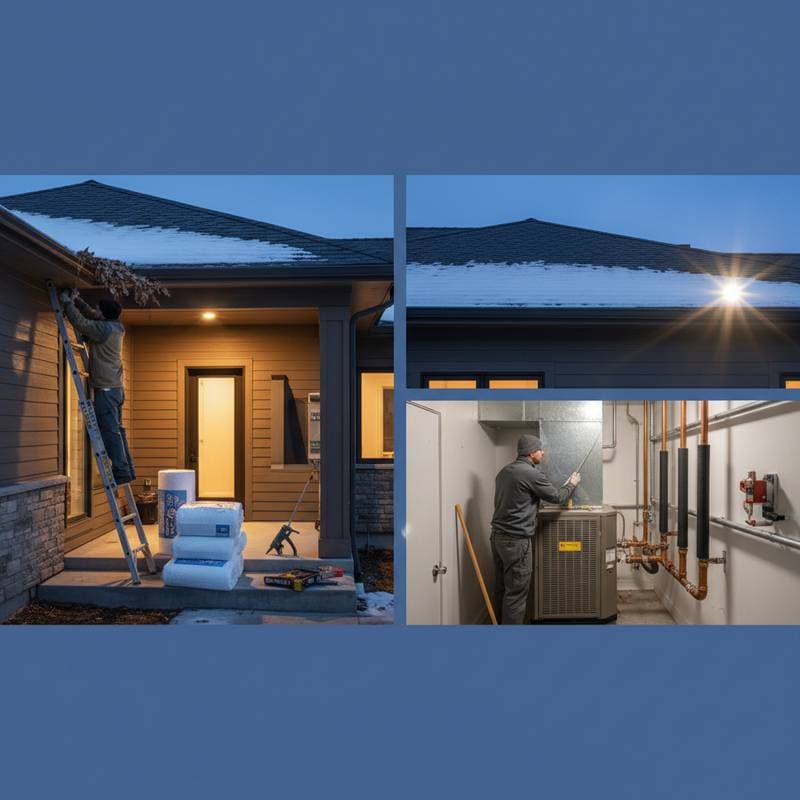Essential Winter Preparation to Prevent Costly Roof Damage
Winter preparation requires action well before the first frost appears. Delaying until cold air seeps through cracks allows minor issues to escalate into major problems. Harsh winter conditions strain roofs, gutters, pipes, and insulation throughout the home. Proactive measures now protect the structure, conserve energy, and avoid substantial repair costs as temperatures plummet.
Key Preparation Steps
- Examine and seal the home's exterior ahead of freezing conditions.
- Clear gutters and downspouts to block ice dam formation.
- Insulate plumbing lines and maintain adequate indoor temperatures.
- Service heating equipment for optimal performance and safety.
- Develop a comprehensive checklist for storm readiness.
Inspect and Maintain the Roof and Gutters
Roofs endure the heaviest impact from winter elements, leading to significant financial burdens if neglected. Accumulated ice and moisture create hidden leaks that damage attic insulation and interior walls. Begin with a thorough inspection for loose shingles, damaged flashing, or structural weaknesses. Hiring a professional for this evaluation costs $150 to $400, a fraction of the thousands required to fix extensive water intrusion.
Gutters demand equal attention to avert ice dams, where frozen water expands and lifts shingles. Remove leaves, twigs, and debris using a stable ladder, protective gloves, and a scoop tool. For those hesitant about heights, professional services range from $100 to $250 based on home size. Regular cleaning ensures proper drainage and reduces the risk of costly winter disruptions.
Seal Doors, Windows, and Exterior Walls
Drafts around windows and doors waste heat and inflate energy expenses. Apply caulk, priced at about $10 per tube, to fill small gaps in frames and trim. Weatherstripping tape or foam seals larger openings effectively, creating a tight barrier against cold air.
Older homes with single-pane windows benefit from plastic film insulation kits, which cut heat loss by up to 20 percent. Apply these films using a hair dryer for a simple, temporary solution. For enduring upgrades, double-pane or low-emissivity windows offer superior efficiency, despite initial costs in the thousands.
Safeguard Plumbing Systems from Freezing
Frozen pipes rank among the top winter hazards, as expanding ice ruptures lines hidden in walls or floors. Insulate exposed pipes in basements, attics, and garages with foam sleeves, available for a few dollars each. This basic step prevents bursts and subsequent flooding.
Add heat tape or cables to particularly vulnerable pipes for reliable warmth, controlled by a thermostat. Follow installation guidelines precisely to avoid hazards. Maintain indoor temperatures above 55 degrees Fahrenheit during absences, and open cabinet doors beneath sinks to allow heat circulation around pipes.
Service the Heating System Thoroughly
Heating equipment demands a pre-winter check to ensure reliability during peak demand. Arrange a professional tune-up, costing $80 to $150, which covers filter replacement, burner inspection, and vent cleaning. For oil or propane systems, verify full tanks and scheduled deliveries.
Change air filters every one to three months to promote efficient airflow and extend equipment life. Restricted filters increase energy use and strain components. Wood-burning appliances require annual chimney inspections to remove creosote and mitigate fire risks.
Handle Exterior and Yard Maintenance
Winter impacts extend beyond the home's interior to surrounding areas. Trim overhanging branches to prevent snow-laden limbs from damaging roofs or utilities. Verify that outdoor lights illuminate pathways and stairs, reducing slip hazards on ice.
Store seasonal items like patio furniture and hoses in protected spaces to shield them from elements. Drain sprinkler systems fully to protect against cracks, and disconnect outdoor faucets by closing interior valves and draining lines. These precautions minimize repair needs after storms.
Build Storm Preparedness and Emergency Plans
Thorough preparation cannot eliminate all winter threats, but it builds resilience. Assemble essentials including bottled water, shelf-stable foods, flashlights, batteries, first-aid supplies, blankets, and a portable power bank. Position these items for quick access during outages.
Test generators monthly, ensuring safe outdoor operation with proper ventilation. Store fuel in compliant containers away from living areas. In outage-prone regions, a standby generator investment safeguards against pipe freezes and food loss.
Practical Strategies for Long-Term Protection
Record all maintenance activities, including receipts and reports, to support insurance processes and boost property value. Evaluate attic insulation depth; add material if joists remain visible to curb heat escape. Balance indoor humidity with a humidifier to protect wood surfaces from dryness.
Test carbon monoxide and smoke detectors regularly, replacing batteries at season's start. These devices provide critical alerts when heating runs continuously. Consistent application of these strategies preserves your home's integrity through winter challenges.
